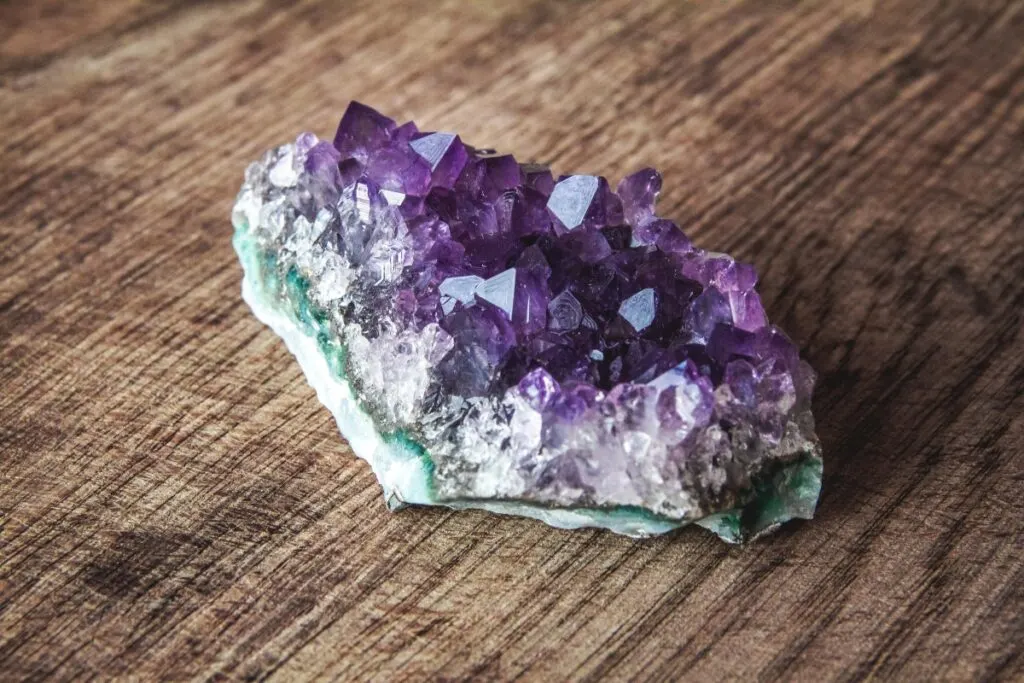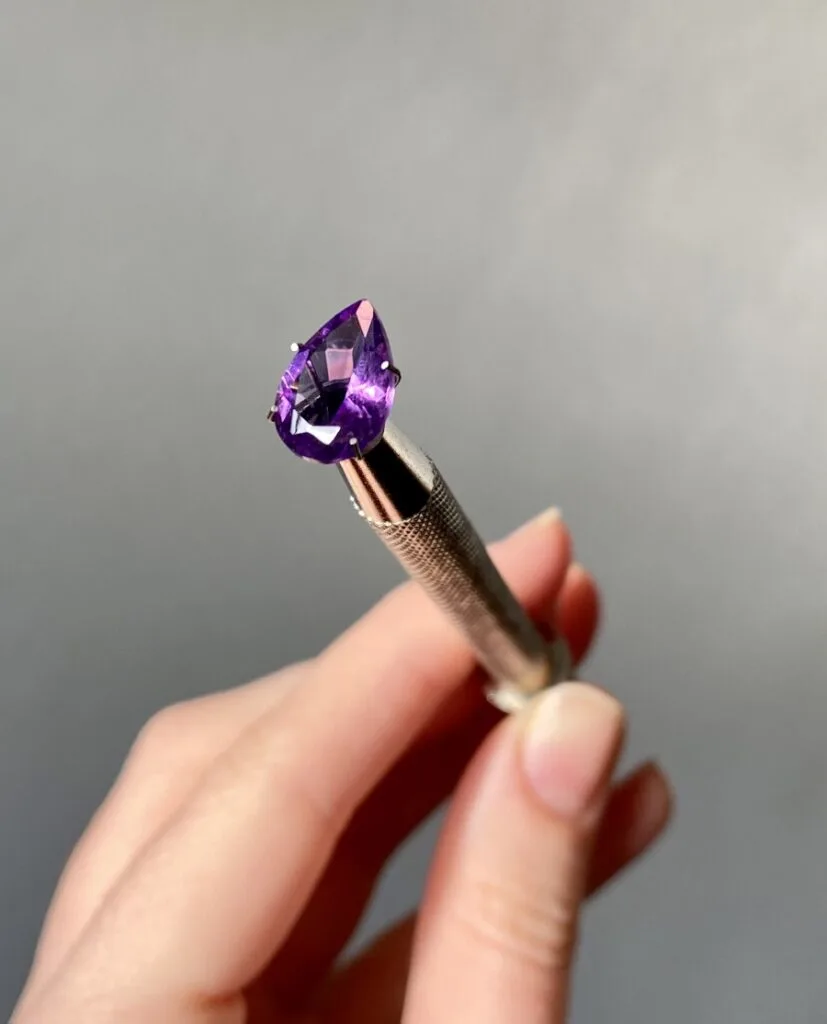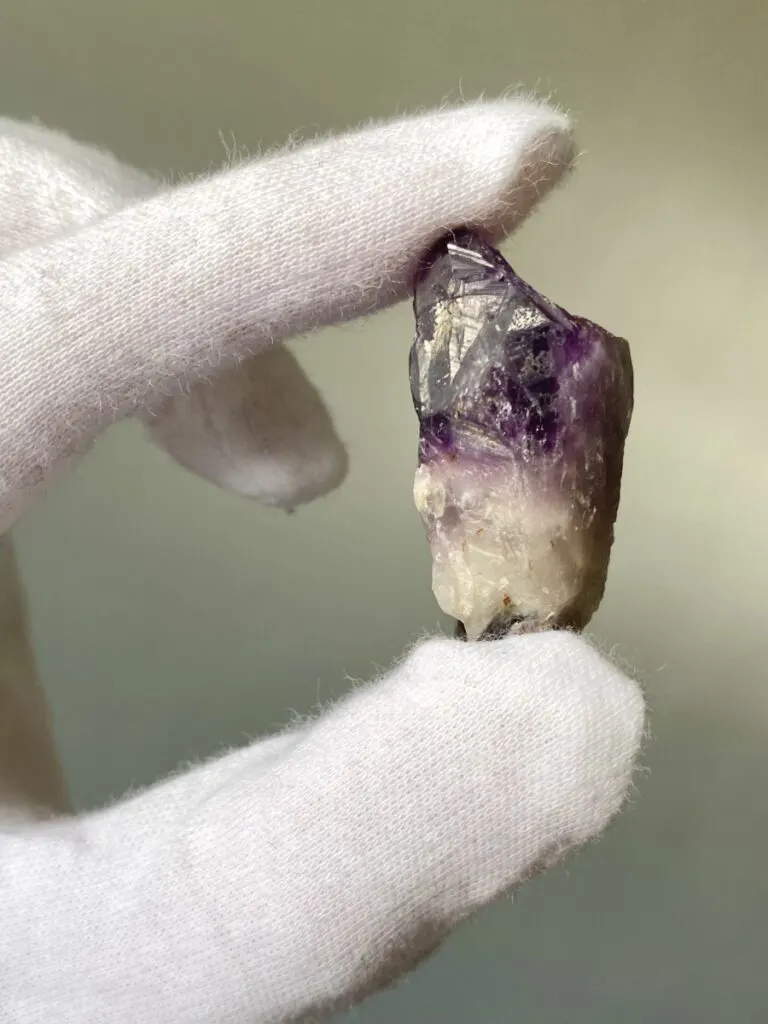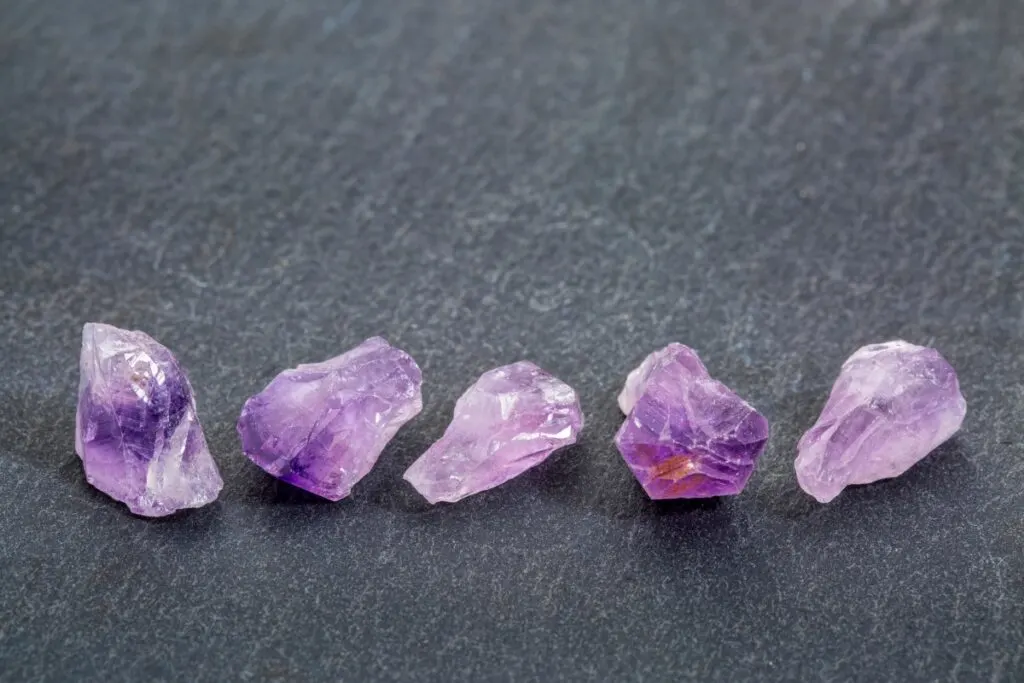As an Amazon Associate, I earn from qualifying purchases with no additional costs for you.
Amethyst’s value depends on various factors like its color, the saturation of the color, the crystal form, and whether it is a separate crystal or a druse. Amethyst is one of the most common minerals. This purple-colored variety of quartz is present almost in every mineral collection.
Amethyst’s value factors are color, clarity, cut, and carat weight. However, additional value factors are the absence of color zoning and heat treatment. Various crystal forms like double-terminated crystals or phantom inclusions can increase amethyst value. Amethyst geodes are highly valuable, either.
Interestingly, many people start their collection exactly from amethyst crystals. Commonly, young mineral collectors (even at the remarkable ages of 7 to 12) are so abashed with vibrant amethyst colors that they begin to become fond of minerals from that moment in their lives once and for all.
Further, you are welcome to learn the value factors of amethyst in detail. Who knows, maybe your old forgotten crystal has something to surprise you and evoke feelings of a young explorer like many years ago.

If you are interested in checking out the best rock and mineral identification books, you can find them by clicking here (Amazon link).
Is Amethyst Worth Anything
For thousands of years, amethyst has been the most prized quartz variety. It accompanied kings, queens, and the highest-ranked bishops. In addition, there were periods when amethyst cost at the same levels as diamonds.
Amethyst is one of the most commercially important gemstones. Its beauty has remained in high demand for hundreds of years. It is usually worth not more than dozens of dollars. However, some stones mounted in historical jewelry have elevated values because of heritage context.

Pear-cut amethyst. (Photo by Olena Rybnikova)
The discovery of Brazilian deposits flooded the world with beautiful amethysts and made them affordable to anyone. However, the abundance of good-quality amethyst crystals doesn’t mean it is worth anything.
Amethyst is used in mass-market jewelry as well as custom-designed pieces. It is one of the world’s most popular colored gems and the most commercially crucial gem-quality quartz.
How Much Is Amethyst Worth
One of the most common and affordable gemstones, amethyst prices for top-quality faceted gems can reach up to $50 per carat ($250 per gram). Occasionally amethysts are sold for up to $100 per carat. Common amethyst crystals (2-5cm long) can be purchased for $1-10.
Why is Amethyst So Expensive? Main Factors
Commonly amethyst is not considered an expensive mineral. The market is full of good quality rough crystals and cut stones.
The abundance of rough amethysts and their quality consistency allow the production of calibrated stones – parcels of faceted stones with equal dimensions- essential for mass-market jewelry production.
The main factors of amethyst value are color and saturation, clarity, cut, carat weight, and the form of crystals (double terminated, phantoms, geode). Amethysts are commonly fancy cut and carved, which positively influences their value and the absence of color zoning and heat treatment.
We need to highlight the difference in value factors between rough crystals and cut stones, as sometimes they work the opposite, as in the case of color zoning.
For example, some mineral collectors prefer mineral samples with distinct color zoning, which makes the sample extraordinary. In contrast, jewelry producers prefer evenly colored stones.
Color
The color of amethyst is the most critical factor of its value. Most people think that the color of amethyst is always purple and consistent. But, let us surprise you – it is not.
The finest amethyst color is a solid reddish purple or purple. Vibrant red and blue flashes are highly desirable and mark the best-quality amethysts. Any brownish or grayish hues decrease the stone’s value.
Saturation of color is also essential. Pale and too-dark stones are considered to be less desirable. Pale stones can be called lavender amethysts or rose amethysts, and oversaturated stones are ink amethysts.
Both light and dark gemstones are less valuable. However, some people prefer these stones, and designers can use them in custom jewelry.

Color zoning in rough amethyst crystal. (Photo by Olena Rybnikova).
Clarity
The requirements for amethyst clarity are incredibly high because of the abundance of material. Eye-clean lack of any eye-visible inclusion stones is the most valuable.
In the case of crystals, some Moroccan amethyst can have a unique feature of hourglass-shaped color zoning. This feature is considered to be highly valuable among mineral collectors.
Carat weight
Amethysts are available in a range of sizes. Some are cut as calibrated stones, and sometimes cutters grind off more material just to fit the required proportions. A general weight rule can be applied to amethysts: the more the weight of the high-quality gemstone, the more the price.
There are no magic numbers like for diamonds that stones more than one carat increase in price dramatically. Just the bigger the stone, the better!
Cut (including craftsmanship)
Amethysts can be perfectly cut. They accept high polish and can be cut in any shape and cutting style (brilliant, step cut, and mix cut). Unlike other gemstones, they are widely faceted of freeform, fantasy, and designer shapes.
One gemstone can be faceted and carved, resulting in a one-of-a-kind gemstone. Color zoning can be an advantage here. Lapidaries can use color zones to enhance their designs.
The form of a crystal
Amethyst crystals can be in different forms. Double-terminated crystals and scepter-type crystals with color zoning or phantoms increase the value of amethyst. The state of natural crystal facets also influences the price. The more natural facets are preserved, the higher the value.
Amethysts are commonly found in geodes. Geodes are special formations in the form of an internal cavity that is lined with crystals. Their size starts from the first centimeters to several meters!
Most often, amethyst geodes come from Brazil and Uruguay (the Rio Grande do Sul region) and are highly praised among mineral collectors and natural science museums.
BTW: Do you want to know more about rock and mineral identification? The books listed below are the best ones you can find on the internet (Amazon links):
- Smithsonian Handbooks: Rocks & Minerals
- Gemstone & Crystal Properties (Quick Study Home)
- Ultimate Explorer Field Guide: Rocks and Minerals (National Geographic Kids)
Some additional factors
Amethyst can be heated to lighten the color of dark-purple stones and make them more marketable. However, this treatment should always be disclosed, and heat-treated stones are less valuable than natural ones.
Also, there are a lot of synthetic amethysts that are only possible to spot with sophisticated gemological equipment. Always ask about the origin of the stone. Synthetic stones are less valuable than natural.
TIP: The most common situation all rock hunters and mineral collectors deal with is at-home mineral identification. Check out the ultimate guide in the article below:
Identifying Minerals and Rocks at Home (Step-by-Step Guide)
Amethyst Price per Pound, Kg, Gram & Carat

Faceted common-quality amethyst is $3-20 per carat ($15-100 per gram). Gem-quality material prices are $30-50 per carat and up to $100 for exceptional stones. Rough amethysts can be purchased for $1-10 per several centimeters piece. Amethyst geode prices range from $10 to thousands of dollars.
The table below is designed to help you understand amethyst prices for different units. The price per in bold is the most common for amethyst of medium quality. Per ounce, pound, and kilo prices are recalculated based on per-gram prices for common-quality material.
| Units | Amethyst price |
|---|---|
| per carat | $3 – 20 for expected quality faceted stones $30 – 50 for gem-quality faceted stones |
| per gram | $15 – 100 for standard quality faceted stones $150 – 250 for gem-quality faceted stones |
| per ounce | $420 – 2,800* |
| per pound | $13 – 45 per rough crystal |
| per kilo | $30 – 100 per rough crystal |
*Recalculated prices for standard quality faceted amethyst.
TIP: Quartz crystals and minerals such as amethyst are among the most popular items collected by rockhounds worldwide. Check out the guide on where to find them in the article below:
Where to Find Quartz: Best Environments & Locations (USA)
Amethyst Price by Color
Even in a narrow range of reddish-purple to violet and bluish-purple colors, amethysts differ in price due to different hues and saturation of color. In addition, some of them have notable trade names for a particular color.
The most valuable amethyst is reddish solid purple or purple, costing around $30 – 50 per carat ($150 – 250 per gram). The most affordable amethysts are of light-purple colors and sold under the trade name Rose de France, and the price for faceted stones is $3 – 10 per carat ($15 – 50 per gram).
In the table below, you are welcome to find approximate prices for amethyst of different colors. However, do not expect a wide range of colors as amethyst colors are different mainly in saturation and hardly noticeable hue.

The most valuable amethyst color is reddish solid purple or purple, which traders sometimes call Siberian. But this is considered misleading as the stone can originate from any part of the world. True Siberian amethysts were of the best quality many years ago, but there is no more supply.
That is why the best-quality amethysts are now called African or Zambian, but again, it doesn’t mean the stone comes from there. In most cases, amethysts come from Brazil.
| Amethyst color | Price |
|---|---|
| Pale and light-colored amethyst (trade name – Roze de France) | $3 – 10 per carat ($15 – 50 per gram) |
| Common purple amethyst | $3 – 20 per carat ($15 – 100 per gram) |
| Dark reddish purple or purple (trade name – African or Zambian amethyst) | $10 – 40 per carat ($50 – 200 per gram) |
| Reddish solid purple or purple (outdated trade name – Siberian) | $30 – 50 per carat ($150 – 250 per gram) |
Also, you can come across names such as green amethyst or yellow amethyst. However, it’s not correct to call these stones that way. If you come across such trade names, most probably, these are natural amethysts that have undergone irradiation and heat treatment, respectively.
Only purple-colored stones can be called amethyst. Green amethyst, whether dyed amethyst or natural quartz, is called Prasiolite. Yellow amethyst should be called citrine with further disclosure of treatment.
TIP: Rock color is the first rock property we pay attention to. Rocks occur in a branch of colors, hues, and saturation. Find out more in the article below:
Rock Colors: What Determines Color & Why Different Colors
Where to Buy Amethyst
It is safe to buy amethysts as they are readily available in good quality. Rough crystals can be purchased via online markets without any fear.
Cut stones are recommended to buy from trustworthy companies because numerous synthetic amethysts are available. Ask about the country of the gemstone’s origin.
Some people prefer eye-to-eye contact during gemstone purchases. You can visit local mineral shows and fairs to buy amethyst. To ensure amethyst authenticity, you can ask for the deposit, locality, or country the sample comes from.
Most of the amethyst on the market today comes from South America and Africa, with incredibly prolific production from Brazil (the continent’s primary source of commercial-quality amethyst) and Zambia.
However, a recent find of amethyst in Marocco discovered a sustainable and ethical amethyst source. Also, fine amethysts have recently emerged from the Four Peaks mine in the US state of Arizona.
BTW: If you are looking for the best UV light for rockhounding, find out my picks below (Amazon links):
- BEST OPTION: Convoy 8+ 365nm UV LED Flashlight with Patented Glass Filter
- BUDGET OPTION: Karrong Rechargeable 1200 Lumen 395nm UV Flashlight
- OPTION FOR INDOOR USAGE: Prime Upgraded Big Chip 396nm UV
Conclusion
Amethyst remains a popular commercial gemstone because of its beauty and abundance. In addition, it is an affordable gemstone. However, the price varies depending on the following quality factors:
- Color. The most valuable color is reddish solid purple or purple.
- Clarity. The absence of any eye-visible inclusion increases the amethyst’s value.
- Cut. Fantasy cuts and carvings make amethysts more valuable.
- Carat weight. Amethyst crystals and cut stones can form rhea hundreds of carats while still holding perfect quality. These stones are more valuable.
- The form of crystals. Scepter or double-terminated crystals are favorable for mineral collectors.
- Locality. Amethysts from Marocco or the US state of Arizona are famous nowadays.
- The presence of treatment. The absence of heat treatment makes amethysts more valuable.
Faceted common-quality amethyst ranges from $3 to 20 per carat ($15-100 per gram). Gem-quality material prices reach up to $30-50 per carat and rarely up to $100 for exceptional gemstones.
Rough amethysts can be purchased for about $1-10 per several centimeters piece. Amethyst geode prices range from $10 to thousands of dollars.
TIP: There are plenty of cool rocks in our little world. Check out the tips on where to find them in the article below:
What are Cool Rocks & Where to Find Them? Follow These Tips
